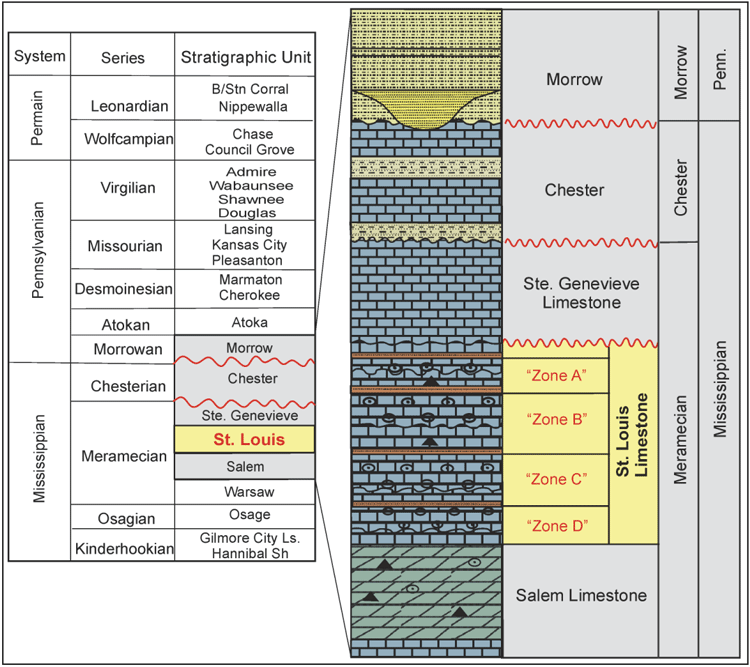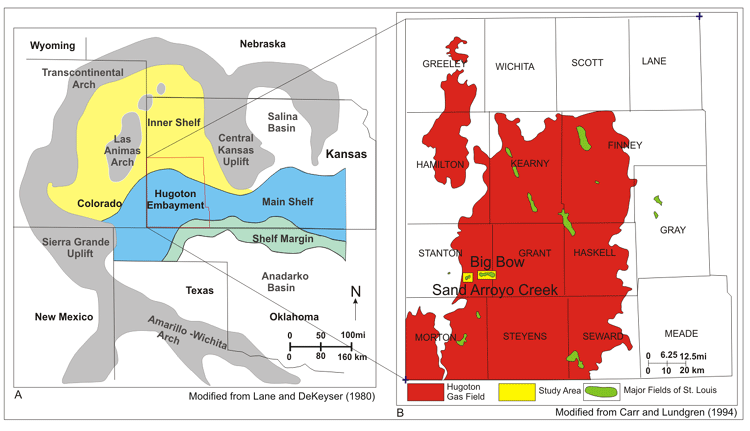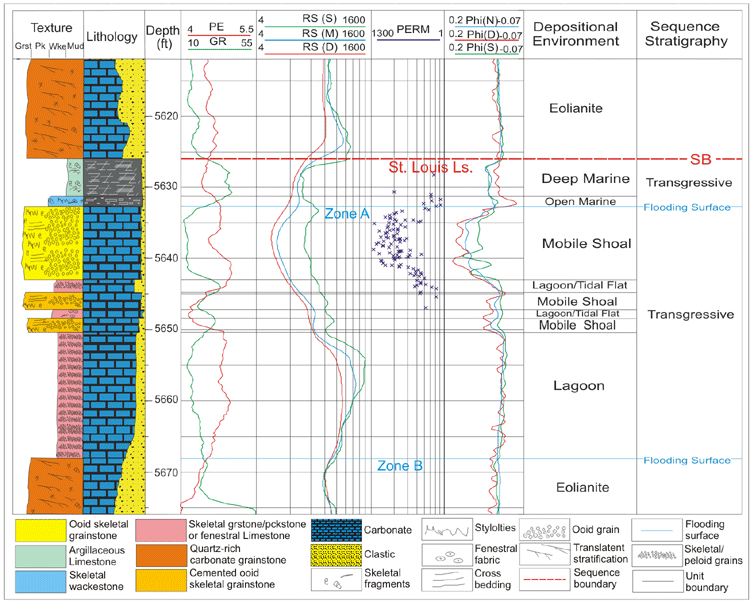Carbonate Lithofacies Prediction Using Neural Network and Geostatistical 3D Modeling of Oolite Shoals, St. Louis Limestone, Southwest Kansas
Qi Lianshuang1,2,3, Timothy R. Carr1, and Robert H. Goldstein3
1Kansas Geological Survey, 2Chevron Energy Technology Company, San Ramon, CA, 3Department of Geology, University of Kansas
Abstract
In the Hugoton Embayment of Kansas, reservoir units in the St. Louis Limestone consist of relatively thin (<4m), spatially scattered, highly heterogeneous oolitic grainstone deposits. Quantifying the distribution of such oolitic deposits is challenging, but essential for improving understanding of sedimentologic processes and developing efficient reservoir management strategies.
A single hidden-layer neural network was used to train and establish a non-linear relationship between lithofacies assignments from detailed core descriptions and selected log curves. Neural network models were optimized and used to predict lithofacies on the entire dataset of the 2,023 half-foot intervals from 10 cored wells. Predicted lithofacies compared to actual lithofacies displays absolute accuracies of 70.37 to 90.82%. Established quantitative relationships between digital well logs and core description data were applied in a probabilistic sense to predict lithofacies in 90 uncored wells across the Big Bow and Sand Arroyo Creek fields.
Predicted lithofacies were integrated with well data to build 3D geostatistical models and stochastic simulations of oolitic reservoirs. The models provide insight into the distribution of facies, the external and internal geometry, and the sedimentologic processes that generated the reservoir units. The depositional pattern and connectivity of modeled oolitic complexes suggest an accumulation of oolitic deposits during pulses of relative sea level rise followed by deepening near the top of the St. Louis. Neural networks and geostatistical 3D modeling can be applicable to other complex carbonate or siliclastic reservoirs in which facies geometry and distribution are the key factors controlling heterogeneity and distribution of rock properties.

Upper Paleozoic stratigraphic column in southwest Kansas showing the carbonate-dominated St. Louis Limestone and the oolitic grainstone intervals classified into local informal subtidal reservoir zones. Predicting the location of individual St. Louis Limestone oolitic deposits, which are isolated and relatively thin intervals (< 4m) interbedded within a thicker (~ 20m) sequence of non-porous deeper-shelf, tidal flat and eolianite deposits, provides a challenge to successful exploration and efficient field development.

Mississippian paleogeography of study area in southwestern Kansas showing the location of Big Bow and Sand Arroyo Creek fields included in the study. The two fields are part of a complex of oolitic reservoirs showing alignment across the Hugoton Embayment. St. Louis Limestone oolitic deposits are distributed as a series of isolated linear belts of shoals trending approximately northwest-southeast across the Hugoton area or laterally confined platform shoals that show a spatial relationship to Mississippian sea-floor highs and barrier islands. During Mississippian time a coincidence of global paleoclimatic, eustatic, and geochemical factors, along with ideal regional paleogeographic and tectonic conditions, resulted in widespread deposition of carbonate oolitic deposits across the North American continent. Significant occurrences of hydrocarbons have been discovered in oolitic reservoirs in the Ste. Genevieve Limestone of the Illinois Basin and the St. Louis Limestone of the Hugoton embayment of southwest Kansas.

Based on core descriptions of cored wells, thin sections, and previous work on the St. Louis Limestone, six major lithofacies were recognized, classified, and interpreted at half-foot intervals. The six classified lithofacies are: 1) quartz-rich carbonate grainstone; 2) argillaceous limestone; 3) skeletal wackestone; 4) skeletal grainstone/packstone; 5) porous ooid grainstone; and 6) cemented ooid grainstone. Based on a variety of evidence including presence of sedimentary structures, general presence of fauna or fossil fragments and grain composition, all six lithofacies were interpreted and associated with depositional environments that follow earlier work.
The six major lithofacies are: 1) quartz-rich carbonate grainstone some of which was deposited by eolian processes adjacent to a coastline; 2) argillaceous limestone deposited in the deepest marine environment; 3) skeletal wackestone deposited in open marine settings; 4) skeletal grainstone/packstone deposited in a restricted lagoonal environment or tidal flat; 5) porous ooid grainstone indicating deposition of shallow-marine shoals on an open shelf; and 6) cemented ooid grainstone deposited in a similar environment as ooid grainstone, but with reduced porosity and permeability due to late compaction and cementation.
http://www.kgs.ku.edu/PRS/publication/2006/OFR06_06.html/p1-01.html
Last Modified April 2006
